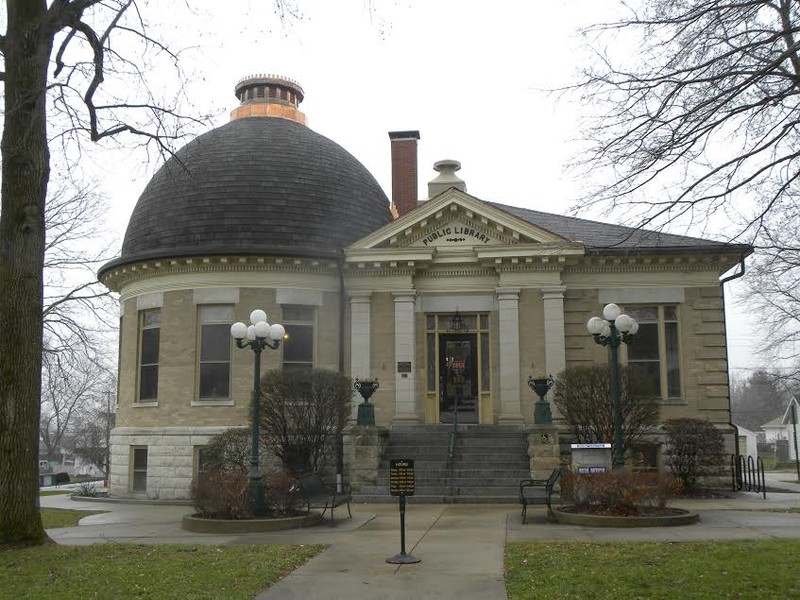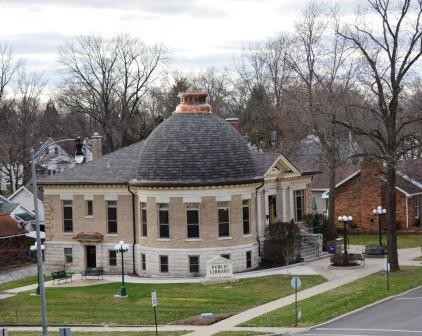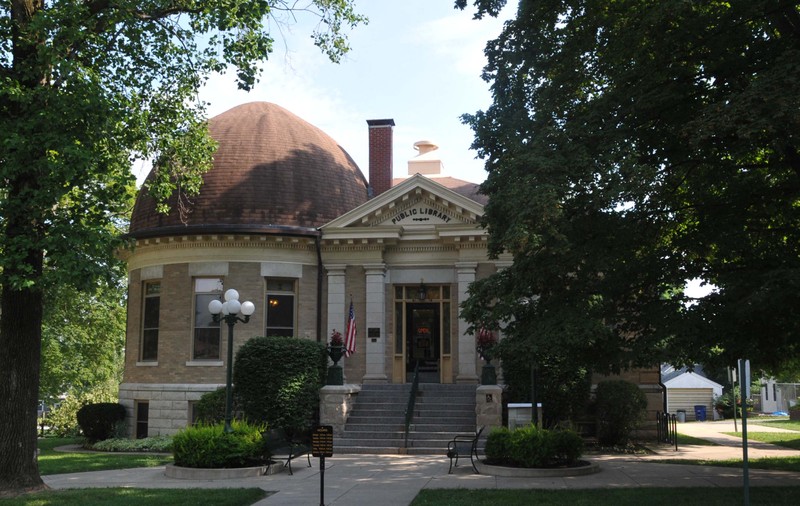Greenville Public Library
Introduction
Text-to-speech Audio
Images



Backstory and Context
Text-to-speech Audio
In 1850, Greenville had three-hundred-seventy-eight residents and the population of the surrounding Bond County totaled five-thousand people. On January 19, 1856, Mrs. E. Hutchinson, Mrs. Robert Stewart, Mrs. Kendall (Elizabeth) Morse, and Mrs. Almire Morse formed the “Ladies’ Social Circle” with the community-minded goal to create a library for their small town. The conviction these four women shared was designed to rid their town of so-called “yellow literature” that was creeping into the populace. The express purpose of the organization, as recorded in the secretary’s book, was “to promote social intercourse and aid in the intellectual and moral elevation of society”. Thanks to the enduring resolve of the Ladies’ Social Circle, the citizens of Greenville have benefitted from library services for over one-hundred-thirty-nine years.
The historical beginnings of the Greenville Public Library are proof enough of the adage, “Never underestimate the power of positive thinking”. The Ladies’ Social Circle has as its objective the purchase of a library for the benefit of its members. Later, it would become an asset to the community. The initial funding began with the original membership of the Ladies’ Social Circle. Any lady could become a member by paying twenty-five cents and regularly attending meetings. Gentlemen could become members of by paying fifty cents semi-annually or one dollar a year. In addition, any lady wanting to aid the project but was unable to attend the meetings could do so by paying twenty-five cents quarterly or one dollar annually.
In the beginning, no money was had for the purchase of books, but that difficulty was prompted solved by another favorite pastime of women during the period – needlework. The first step was a room full of ladies and a paper full of needles – Sharpe’s no. 7. Goods were purchased and articles made for sale. Items made included shirts, sun bonnets, night caps, pantalettes, cradle quilts, purses, and stockings. The Circle’s first fund raising supper was given in the old Congregational Church building. The Congregational Church was built on ground donated by Mr. Seth Blanchard, brother of Mrs. Almira Morse, who stipulated that the church should ever be torn down or moved away, the lot should therefore be used for some public purpose. This is the same site on which the Greenville Public Library would be built.
In the spring of 1856, a supper was held in Dr. Sprague’s Hall. About one hundred people attended, and the ladies earned $61.88. Their money was loaned out at a hefty ten percent interest and the sum of one hundred dollars was accumulated in August 1856. With these funds, the Ladies’ Social Circle was able to make its first purchase of books. The ladies had one iron rule: “no fiction allowed”, not even Scott’s novels or Dickens’ works. The women had low finances but lofty ideals.
The library collection was housed in the parlor closets of Mrs. Almira Morse’s home, trading hands with varying Circle members acting as librarians until ultimately the collection became too large to contain within a home. In 1861, a space was secured upstairs over Mr. C. R. Bennett’s drugstore on North Third Street at the cost of fifty dollars a year. The Library Association, dedicated to the original purpose of the group, carefully chose the books placed on the shelves, and by 1887 the library had accumulated eight-hundred-seventy-one volumes. In February 1867, the Ladies’ Social Circle legally incorporated under the name, The Ladies’ Library Association of Greenville, Illinois.
In 1903, the population of Greenville had passed three thousand, and the Ladies’ Library Association decided the time had come to push for a more permanent housing for the library. Having learned of Andrew Carnegie’s library philanthropy Mrs. Juliette W. Hoiles, President of the Library Association, asked Illinois Lieutenant Governor William A. Northcott, who lived in Greenville, to correspond to James Bertram, secretary to Andrew Carnegie, about the possibility of obtaining a Carnegie Library for Greenville. The Association, by this time, was able to offer fifteen hundred dollars and their collection of approximately three thousand books.
Mr. Carnegie responded with a proposal. He offered to give ten thousand dollars to build a library if the City of Greenville would furnish the land and levy a permanent tax equal to ten percent of the building cost per year to support the library. In addition, the Ladies’ Library Association was to turn over to the city their books and any accumulated cash. On May 6, 1903, the Association and Greenville city officials met to consider Mr. Carnegie's offer. They quickly came to the realization that this was a splendid opportunity. Mayor Edmond DeMoulin and the City Council unanimously voted to levy a tax to raise the amount needed to support the library. The City Council appointed five men and four women to serve on the Library Board of Directors. A committee was then named to solicit subscriptions for the purpose of purchasing a site for the library.
In October 1903, the Library Board of Directors agreed that the Greenville Public Library would be built on the land where the old Congregational Church had stood from 1839 to 1903. To purchase the site, $1,250 was subscribed and donated by the businessmen and citizens of Greenville and the Ladies’ Library Association. The opening of the new Greenville Public Library was held on Friday, April 4, 1905 at eight o’clock in the evening. Despite the designs for the Greenville Public Library not being reviewed by Andrew Carnegie or James Bertram, the floor plan of the building possesses many of the features that were suggested for later Carnegie libraries.
Sources
Greenville Public Library, National Register of Historic Places. Accessed January 4th 2021. https://catalog.archives.gov/id/28890723.
Who We Are - The Library's History, Greenville Public Library. Accessed January 22nd 2021. https://www.greenvillepubliclibrary.org/about-us.
